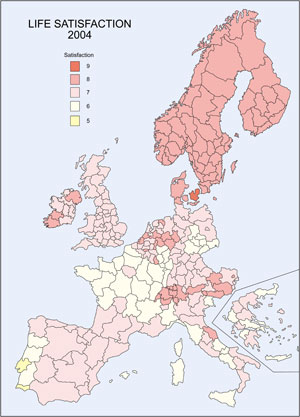
How happy are you? (Figure by Aslam and Corrado, 2007. Used with permission)
How happy do you feel today? How satisfied are you with your life as a whole?
If you live in the EU, then economists Luisa Corrado and Aqib Aslam probably have a good idea of how you might answer, and most importantly, they have discovered that it is not a matter of your circumstances alone. How you rate your happiness and life satisfaction is significantly influenced by your neighbourhood, and these local factors have a greater impact than any national effects.
Corrado and Aslam, both from the University of Cambridge, came to these conclusions using data from the European Social Survey (ESS), a survey that occurs every two years involving nearly 40,000 respondents from across the EU. The survey asks questions about people's individual situation (such as their income, household structure, gender and age), and their views on society, politics, and their own lives. Questions about the more subjective concepts might be "Would you say that most people can be trusted, or that you can't be too careful?", "How satisfied are you with your life in general?", "How happy are you?", "How often do you meet socially with friends or family?", "How much do you personally trust the government, the legal system, the police?" — with the answers to these questions usually rated on a scale.
The aim of this research was to understand how interactions with other people affect our sense of well-being. It might seem obvious that our relationships with other people and our participation in society will affect how happy we feel, but these sort of interpersonal factors are not usually considered in social statistics. Traditionally when analysing social and economic data, all the individuals involved are assumed to be independent of each other. In reality, it is known that in a population which is inherently grouped, such as residents of the EU clearly falling into the geographic groups of countries and local regions within those countries, there will be some kind of dependence within those groups. It has long been suspected that assuming individuals in a population operate independently can introduce serious bias into any results, but it is only recently that researchers have attempted to include group dependence into any analysis.
To test whether these two levels of geographic groups — EU countries and local regions (counties such as inner London, Kent, Cornwall or Cumbria in the UK, or regions such as Basque and Andalusia in Spain) within those countries — had an impact on well-being, Corrado and Aslam analysed the way reported happiness and life satisfaction varied. If it was strongly affected by your interaction with members of your group, then the differences between groups would outweigh the differences seen within your group. The economists measured this by examining the excess variance, which compares the differences in the data within the group, compared to the differences between groups. They found that both the country and regional groups affected an individual's reported levels of happiness and life satisfaction (thought of as the short-term and long-term measures of well-being respectively), and that these regional effects were the most significant.

Feeling satisfied? (Figure by Aslam and Corrado, 2007. Used with permission)
Once they had established that these regional and national influences were important factors, Corrado and Aslam developed a model that tried to understand how they contributed to our well-being. They used a standard statistical tool, known as multilevel modeling, to understand how the variables of happiness and life satisfaction depended on the three levels of individual, regional and national factors. In addition to variables commonly used in models of well-being, such as income, health, education, they also included interpersonal factors such as social relationships and trust. In particular, they included social norms, which were regional and national averages of these factors, as well as other higher level indicators such as national and regional GDP, population density and location.
This is the first attempt to use a multilevel model to understand what determines well-being, and the first time that the regional influences have been shown to be a significant factor. Corrado and Aslam say their research is still preliminary, and there is much work still to be done. They will present the results of their analysis at the European Survey Research Association Conference in Prague in 2007, and hope to aid in the development of additional questions for the ESS on attitudes that can be used to refine their model. But they are certainly very happy with the results so far.
Further reading
- You can read more about this research in the paper by Aqib Aslam and Luisa Corrado.
- The website of the European Social Survey.